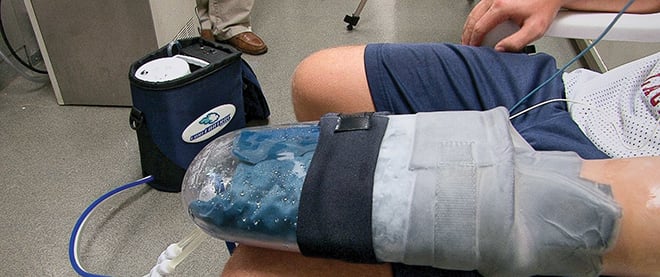Looking for an edge: cooling your palms works ‘better than steroids’
Stanford University’s cooling glove speeds recovery and improves athletic performance drastically
Steve Fyffe/Stanford University
Share

Ice baths were all the rage at the London 2012 Summer Games as a way for Olympians to reduce inflammation, speed muscle recovery between events—and make funny faces during the exquisite agony of immersion. Rowers used them, cyclists used them; British distance runner Mo Farah, looking profoundly chilled, took the plunge, and delivered back-to-back gold medals in the gruelling 10,000-m and 5,000-m races. Now, researchers at Stanford University have devised a faster and less cringe-worthy way of cooling the body, speeding recovery and delivering a performance boost “substantially better than steroids.”
The device is a rigid plastic mitt that forms a slight vacuum and circulates cool water to extract heat from the palm of a hand, where blood vessels act as a high-efficiency radiator for the human body. The device, developed by Stanford biologists H. Craig Heller and Dennis Grahn, can alter a person’s core temperature within 10 minutes, raising temperature with warm water for a person coming out of anaesthesia, for instance, or dropping it to speed muscle recovery in athletes.
Use of a single cooling glove between sets of chin-ups turned fellow researcher Vinh Cao into a near superhero, erasing muscle fatigue so much he was able to boost his daily capacity for chin-ups to 620 from 180. Stanford sports teams as well as the local San Francisco 49ers and Oakland Raiders football teams have used versions of the glove, which will soon become commercially available. “The work capacity of muscles was greatly enhanced by palm cooling, and when this benefit was applied to strength-conditioning regimes, the rates of gain were dramatic, exceeding what has been observed through the use of anabolic steroids,” the authors say in a research paper.
The researchers claim the device has the potential to save lives of athletes competing or practising in high temperatures, noting that “heat stroke is one of the leading causes of sudden death in sport.” They are also exploring the concept of a “wearable” palm cooling device that could be used by firefighters or people cocooned in stifling chemical or biological protective gear. Such devices may also have applications on the battlefield. While it’s not a topic the authors discuss, study notes show the research was supported by a grant from the U.S. Department of Defense Advanced Research Projects Agency.